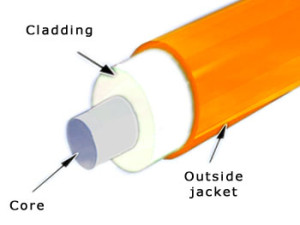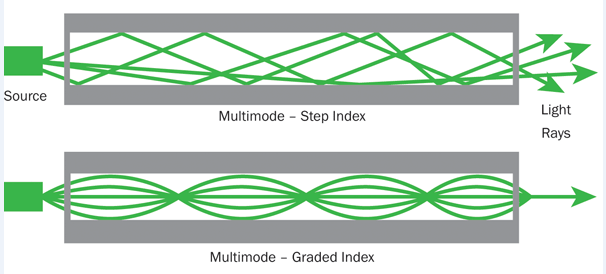 An optical fiber is a flexible, transparent fiber made of extruded glass or plastic, slightly thicker than a human hair. Optical fibers are used most often as a means to transmit light between the two ends of the fiber and find wide usage in fiber-optic communications, where they permit transmission over longer distances and at higher bandwidths than wire cables. Optical fibers typically include a transparent core surrounded by a transparent cladding material with a lower index of refraction. Light is kept in the core by the phenomenon of total internal reflection which causes the fiber to act as a waveguide. In general, there are two kinds of optical fiber: fibers that support many propagation paths or transverse modes are called multimode fibers (MMF), while those that support a single mode are called single mode fibers (SMF). Single mode vs multimode fiber: what’s difference between them? Reading this text will help you get the answer.
An optical fiber is a flexible, transparent fiber made of extruded glass or plastic, slightly thicker than a human hair. Optical fibers are used most often as a means to transmit light between the two ends of the fiber and find wide usage in fiber-optic communications, where they permit transmission over longer distances and at higher bandwidths than wire cables. Optical fibers typically include a transparent core surrounded by a transparent cladding material with a lower index of refraction. Light is kept in the core by the phenomenon of total internal reflection which causes the fiber to act as a waveguide. In general, there are two kinds of optical fiber: fibers that support many propagation paths or transverse modes are called multimode fibers (MMF), while those that support a single mode are called single mode fibers (SMF). Single mode vs multimode fiber: what’s difference between them? Reading this text will help you get the answer.
Single Mode vs Multimode Fiber: What’s single mode optical fiber?
In fiber-optic communication, a single mode optical fiber (SMF) is an optical fiber designed to carry light only directly down the fibre – the transverse mode. For single mode optical fiber, no matter it operates at 100 Mbit/s or 1 Gbit/s date rates , the transmission distance can reach to at least 5 km. Typically, it is used for long-distance signal transmission.
Single Mode vs Multimode Fiber: What’s multimode optical fiber?
Multimode optical fiber (MMF) is a type of optical fiber mostly used for communication over short distances, such as within a building or on a campus. Typical transmission speed and distance limits are 100 Mbit/s for distances up to 2 km (100BASE-FX), 1 Gbit/s up to 1000m, and 10 Gbit/s up to 550 m. There are two kinds of multimode indexes: step index and graded index.
What’s difference between single mode optical fiber and multimode?
- Core diameter
The main difference between multimode and single mode fiber is that the former has much larger core diameter, typically has a core diameter of 50 or 62.5 µm and a cladding diameter of 125 µm. While a typical single mode fiber has a core diameter between 8 and 10 µm and a cladding diameter of 125 µm.
- Optical source
Both lasers and LEDs are used as light sources. Laser light sources are significantly more expensive than LED light sources however they produce a light that can be precisely controlled and which has a high power. Because the LED light sources produce a more dispersed light source (many modes of light) these light sources are used with multimode
cable. While a laser source is used (which produces close to a single mode of light) with single mode cable.
- Bandwidth
Since multimode fiber has a larger core-size than single mode fiber, it supports more than one propagation mode. Besides, like multimode fibers, single-mode fibers do exhibit modal dispersion resulting from multiple spatial modes, but the modal dispersion of single mode fiber is less than multi-mode fiber. For these reasons, single mode fibers can have a higher bandwidth than multi-mode fibers.
- Jacket color
Jacket color is sometimes used to distinguish multimode cables from single mode ones. The standard TIA-598C recommends, for non-military applications, the use of a yellow jacket for single mode fiber, and orange or aqua for multimode fiber, depending on type. Some vendors use violet to distinguish higher performance OM4 communications fiber from other types.
- Modal dispersion
The LED light sources sometimes used with multimode fiber produce a range of wavelengths and these each propagate at different speeds. This will lead to much modal dispersion, which is a limit to the useful length for multimode fiber optic cable. In contrast, the lasers used to drive single mode fibers produce coherent light of a single wavelength. Hence its modal dispersion is much less than multimode fiber. Due to the modal dispersion, multimode fiber has higher pulse spreading rates than single mode fiber, limiting multimode fiber’s information transmission capacity.
- Price
For multimode fiber can support multiple light mode, the price of it is higher than single-mode fiber. But in terms of the equipment, because single mode fiber normally uses solid-state laser diodes, therefore, the equipment for single mode fiber is more expensive than equipment for multimode fiber. And for this reason , the cost of using multimode fiber is much less than using single-mode fiber instead.
Single Mode vs Multimode Fiber: What kind of optical fiber should I choose?
This is based on transmission distance to be covered as well as the overall budget allowed. If the distance is less than a couple of miles, multimode fiber will work well and transmission system costs (transmitter and receiver) will be in the $500 to $800 range. If the distance to be covered is more than 3-5 miles, single mode fiber is the choice. Transmission systems designed for use with this fiber will typically cost more than $1000 due to the increased cost of the laser diode. Single mode vs multimode fiber: Do you know the differences now?
Related Article: Single Mode Fiber: How Much Do You Know?






